Caring for Antique
Quilts
by Bob Brooke
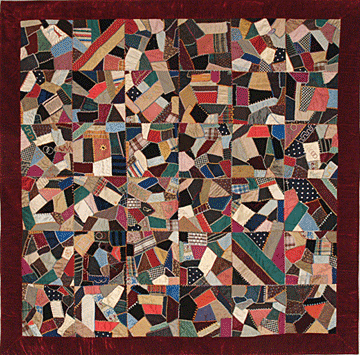 You’ve
just purchased or inherited an old quilt. It’s a real beauty, a
geometric design in red and blue. The quilting is exquisite. But it’s
looking a bit dingy. So how do you clean and care for it? You’ve
just purchased or inherited an old quilt. It’s a real beauty, a
geometric design in red and blue. The quilting is exquisite. But it’s
looking a bit dingy. So how do you clean and care for it?
Based on the straight-edge geometric design and the colors, your quilt
was probably made by a Pennsylvania Amish woman or a group of them.
Based on its fabrics, it may date from the turn of the 20th century.
Tiny patchwork pieces demonstrate frugality and patience. However, wWhen
using design motifs to estimate a quilt's age, keep in mind that the
fabrics used in it might be a decade or two older than the quilt itself.
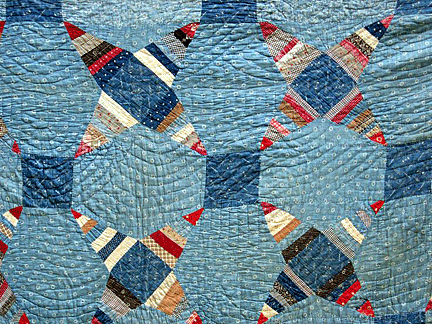 A
quilt's fabric can tell you a lot about its age. The earliest quilts
were made of homespun cloth; print materials became common after 1820.
Nineteenth-century quilts used cotton—calico, gingham, muslin and
solids—along with wool and challis. Frontier women employed muslin,
sacking and sample swatches. Victorian-era quilters incorporated
expensive fabrics such as silk, taffeta, velvet and satin. By the
mid-1800s, women were buying fabric specifically for quilting. During
the crazy-quilt mania of the 1880s, manufacturers started selling
bundled scraps. Some turn-of-the-century quilts incorporate feed or
sugar sacks and even silk swatches that were put in cigarette packs to
encourage women to smoke. A
quilt's fabric can tell you a lot about its age. The earliest quilts
were made of homespun cloth; print materials became common after 1820.
Nineteenth-century quilts used cotton—calico, gingham, muslin and
solids—along with wool and challis. Frontier women employed muslin,
sacking and sample swatches. Victorian-era quilters incorporated
expensive fabrics such as silk, taffeta, velvet and satin. By the
mid-1800s, women were buying fabric specifically for quilting. During
the crazy-quilt mania of the 1880s, manufacturers started selling
bundled scraps. Some turn-of-the-century quilts incorporate feed or
sugar sacks and even silk swatches that were put in cigarette packs to
encourage women to smoke.
Handling an Old Quilt
Wear a pair of white cotton gloves when you handle an
antique quilt. The oils on your fingers can do damage to the fabric over
time. Keep quilts on clean, dry surfaces. Lay a clean bedsheet down
first, then lay the quilt on top of it.
Cleaning an Antique Quilt
If your quilt is over 50 years old, it should be cleaned
by a professional. Many conservators recommend not cleaning an antique
quilt because the fibers can become brittle over time. One of the best
ways to clean a newer quilt is with a handheld vacuum cleaner with a
small brush attachment. Lay the quilt out on a flat surface and place a
nylon stocking over the end of the nozzle or use a soft brush attachment
before vacuuming. You also can air your quilt outside on an overcast day
to remove dirt and odors.
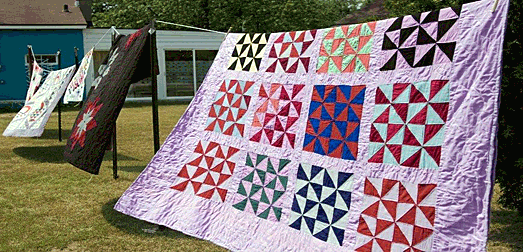
Since fabric of different types make up most quilts, it’s best not to
wash a quilt. Also, today’s powerful washing machines will mostly likely
damage it.
Antique quilts are also susceptible to molds and insects. The growth of
molds can lead to scattered spots known as foxing, similar to those
found on old prints. What may look like a blood or rust stain is what’s
left of a dead bug. These stains are nearly impossible to remove. Many
quilts folded and stored for years will have brown stains that often
look like furniture polish, blood or rust but are actually caused by dye
migration. Changes in temperatures can cause this to happen and most
stains caused by dye migration cannot be removed because the dye has
permanently stained adjoining fabrics. It’s best to leave this alone, as
you can do more damage trying to remove dye migration.
Storing an Antique Quilt
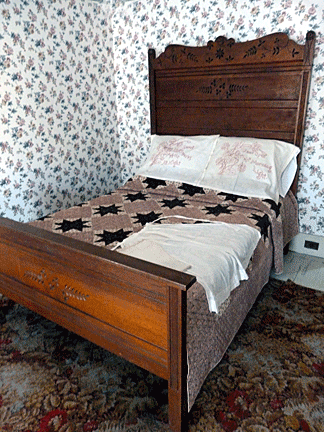 The
best way to store—and display—a quilt is on an unused bed. Keeping pets
and sunshine off the quilt will extend the lifetime of the fabric. Don't
banish your quilt to the attic or basement; opt instead for a
low-humidity, constant-temperature area. Periodically rest hanging
quilts to reduce the stress on the fabric. Never nail or tack a quilt to
the wall, and don't pin anything to your heirloom—the pins can leave
rust marks. The
best way to store—and display—a quilt is on an unused bed. Keeping pets
and sunshine off the quilt will extend the lifetime of the fabric. Don't
banish your quilt to the attic or basement; opt instead for a
low-humidity, constant-temperature area. Periodically rest hanging
quilts to reduce the stress on the fabric. Never nail or tack a quilt to
the wall, and don't pin anything to your heirloom—the pins can leave
rust marks.
You can store your quilt in an acid-free box, wrap it in a piece of
washed, unbleached muslin or fold it in a pillowcase. Never keep it in a
cardboard box or plastic bag. If you want to store it in a wooden
drawer, first paint the inside with polyurethane varnish and after it's
dried, line the drawer with acid-free paper, cotton sheets or muslin.
Refold the quilts a few times a year to avoid permanent creases. Smaller
quilts can be rolled around a cardboard tube wrapped in acid-free paper.
If space is at a premium or if your quilt contains thick stuffed work or
embellishments, it’s preferred to store it folded or around a cardboard
tube that has been first wrapped with aluminum foil and a white bedsheet.
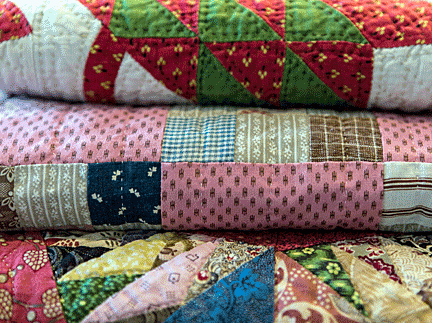 If
you have several quilts, don’t stack them to store them, but buy special
acid-free boxes online in which you can store each quilt. While you’re
at it, also purchase some acid-free tissue paper to lay in the folds.
You can also store your antique quilt in a clean white pillow case. If
you have several quilts, don’t stack them to store them, but buy special
acid-free boxes online in which you can store each quilt. While you’re
at it, also purchase some acid-free tissue paper to lay in the folds.
You can also store your antique quilt in a clean white pillow case.
Remember, you own an original piece of American history. With proper
care, your quilt will last a long time.
<
Back to Caring for Your Collections
Archives
Next Article >
|
